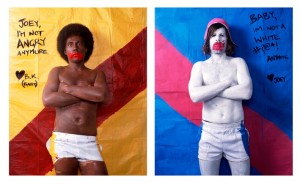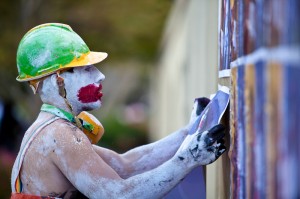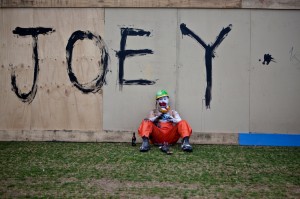Sharne Wolff interviews Eric Bridgeman and discusses identity, photography and tips a winner…
Sharne Wolff: First up I have to ask you – did you watch the NRL game at Suncorp on Saturday night [Brisbane v St George]?
Eric Bridgeman: No I didn’t. People often ask me about football matches, what I think about a certain game or how the season’s going. I have (over the years) removed myself from the actual ‘game’ or the physical playing. I find it repetitive and it takes a number of pints to get me into it these days – which isn’t so bad – it’s how most of the fun happens at matches or pubs. I’ve always been an observer, pervert maybe, more interested in the social/cultural/political dynamics of the game, which I see as a sport in itself and much deeper and amazing than the cyclical struggle to get a ball to the end of a field and a teams fight to yet again be champions. I do like the game for a lot of reasons, but I don’t have much of an interest in the ball and where it’s going. I watch for many other reasons, and I believe that’s okay too. As a whole I see the game as a simple and very basic human thing. Yet I’m sure that fans and pros would argue with that. To me it plays out like an army of sperm flighting towards an ovary. The best of the best sperm you can find. I have my moments where I get involved and enjoy. But most of the time I am reminded why I became so judgemental of Rugby League and the culture. So to actually switch off, I won’t watch it at all because it makes me anxious and horny.
SW: I understand that your mother was born in PNG and your father is a Queenslander. Do you think your mixed cultural heritage has informed your work in any particular way?
EB: Early on I touched explicitly on my father’s hometown, Cracow, in central Queensland. After that I realised I was only touching on half of the story, maybe due to fear. The mixed race thing has always given me a lot to think about. I let myself go with the chaos of fusing both and seeing what happens. It feels more honest, natural, insane and fun. I’ve spent most of my life in Australia, growing up and school. So I got to a stage where I wanted more. And I had it just 3 hours plane ride over to PNG. I think my work took off (for me) when I made the move to expose myself for the mongrel I am. I have been heading back to my village in Chimbu Province in the Highlands over the last four years. After art school I’ve been trying to make it a regular thing every year. Fully understanding its potential is a work in progress. I’ve been going mainly to let go of my ‘self’ that I’ve known most of my life. To become what I could’ve and could still be, if I decide to. It’s about learning, reuniting, touching my home ground and just being a man in my village, on my land, where I am loved and where I have another life. My mother is from PNG and met my dad while he was working over there in the ‘70s. I guess in a simple way the dual thing has informed my life therefore it informs my work. But this is just the beginning – who knows what I’ll be into later on? I want to be interested in something else later on. Identity has been a problem for me really, not just in life but in art too. I love it but I also want to destroy it.
SW: So far, 2011 seems to be your year – two solo shows in Melbourne, selection for Primavera 2011 Young Australian Artists at the Museum of Contemporary Art, Sydney and the upcoming National Artists’ Self Portrait Prize exhibition at the University of Queensland Art Museum. How do you feel about being selected for Primavera and what do you think it might mean for your career?
EB: I feel it’s been my least productive year so far for work – but I have important shows and things happening. Sydney is my favourite place to be and make work. It’s like a fantasy island in the harbour. I feel humbled. A little nervous but ready. I am a reluctant performer so I’m always nervous. But I feel good about Primavera. I don’t really think about what it can do for my career, but more what it can do for me right now. Which is having a good time, making work in the harbour, and meeting amazing people. I have those moments when I’m drinking champagne in fine company, maybe looking at the harbour at night, talking about art and how wonderful it is. I think about my family back in the village in PNG. I think to myself, ‘I’m not just a hooligan, I am doing something important’. Even if all it does is afford me my next ticket back to the village. I like meeting people. When people seem to move mountains to enable me to do what I want to do, I feel somewhat blessed.
SW: Did you play sport as a kid?
EB: Yeah, I started early with soccer, then swimming, AFL, Rugby League. This is what my mum got me into. At the same time my dad would take me to my first art classes, piano and clarinet lessons, buy me my first SLR camera. What’s a kid to do with so many choices? Become bi-curious maybe.
SW: Do you like to work in analogue or digital, and why?
EB: I only use analogue for my important photographs. I got over digital once I realised it all became digital landfill on your computer never to be seen again. They began to feel worthless. And I don’t think I trust having important pictures in digital format, probably because I don’t know how computers work and that’s not something I aspire to know at the moment. With my Mamyia RB67 medium format I know that I make the pictures – like they came from me – and that’s an important and good feeling to have when making work.
SW: It seems to me that your work is a curious mixture of affection and ridicule for the characters you choose to photograph. What do you think?
EB: That’s a dilemma. A problem. Wanting to be part of it while knowing it’s bad for me. There’s affection but I don’t always set to ridicule, it’s more of a debate between good and bad feelings. It might seem like ridicule because it usually ends up funny, like I’m taking the piss. I try my best not to name and shame people, because I want the work to consider bigger ideas than the individual, and to discuss the struggle itself. I sometimes use a real personality, hero or icon as a starting point, and the rest is built on fantasy. Joey/Baby [part of the Primavera series of work] is the most direct I’ve been, even though it’s an obscured representation of a real event or people. The only true link to a real individual is the nickname ‘Joey’. This then takes on the form of Concrete Blonde’s song ‘Joey’. I try to manipulate only through symbols and simplified gestures, like colours, designs, materials and poses. The photographs are a concoction of things. If I am drawing from a real individual, by the time the work is finished it needs to be as far away from that person as possible. The individual is just a small ingredient. I don’t want to make satire about celebrities, only use a small part of them to construct a bigger, more complex picture of a social or cultural situation. I am aware of the power of popular media and am often arguing with the TV or newspaper. I use the things I need to stay on the level of the public, to contribute to a discussion, and as a way of making my work and thoughts accessible. I’m a supporter of Melbourne Storm. Even though I’m often caught taking the piss and saying shit about Rugby League, I ran into the team at the airport a couple of weeks ago. Like most people I still get weak at the knees.
SW: I first saw your work in ‘The State We’re In’, the photography exhibition of Queensland photographers at UQ Art Museum last year which included some of your mentors and teachers such as Marian Drew and Ray Cook, themselves well-known photographers. How have artists such as these influenced your work?
EB: Ray Cook was my first photography teacher and mentor. And is still my dear friend. I was 18 when I arrived at the Queensland College of Art and I don’t know if I’d have survived if he wasn’t there. Art colleges seem to come with their old and tired left/right institutional politics. People like Ray pushed me through the cracks. Celebrated and nurtured me when I needed it. It was also his first year of teaching, so I think it was important for both of us to find each other at that time. To me his work seemed fearless and I wanted to be fearless too. Marian Drew was a good force behind me at that time too. Wanting to make performance art and installation doesn’t come without questions from a photography department. During my time with them at QCA I did play with elements of photography they’d perfected in their own practices, painting with light and performance, because I admired what they do and who they are. I think it’s about attraction. If I’m attracted to another artist’s work and we meet somehow and maybe something comes from it. Maybe it will influence work directly, but mostly it’s about sharing ideas, meeting of minds and confidence. After art school I’ve been lucky to be surrounded by many more artists who have played some part. Scott Redford and Brook Andrew are quite good to me at the moment. It helps to know they are there if you need them.
SW: The democratisation of the internet means that these days everyone is a photographer or a filmmaker. What do you think it is that sets you and other artists apart?
EB: I think everybody IS a photographer/filmmaker. I think that’s great and the wonderful thing about the technology. It’s not an elitist medium like painting. It belongs to everybody; the common people. What sets us apart is that we could be obsessed, even more than people on Facebook. I can’t speak for everyone else’s process, but I might spend a whole year intensely planning and dissecting just five photographs or less. It’s not a hobby at the moment. I love the medium but I often turn on it. I also hate it.
Who is going to win the Grand Final?
EB: Melbourne Storm will get their cup back. And I’ll be at the after-party doing shots off their chests.
Eric Bridgeman aka ‘Boi Boi the Labourer’ is performing at Primavera from 1-2pm on Saturday 24 September. Primavera 2011: Young Australian Artists is at the Museum of Contemporary Art [offsite] in Sydney until 13 November. www.pv11.com.au
Eric’s most recent solo show was held with Gallerysmith in Melbourne. The Gallery plans to exhibit works by him at the Melbourne Art Fair 2012. www.gallerysmith.com.au.
The National Artists Self Portrait Prize 2011 curated by Alison Kubler opens 24 September at the University of Queensland Art Museum and runs until 12 February 2012. www.artmuseum.uq.edu.au



